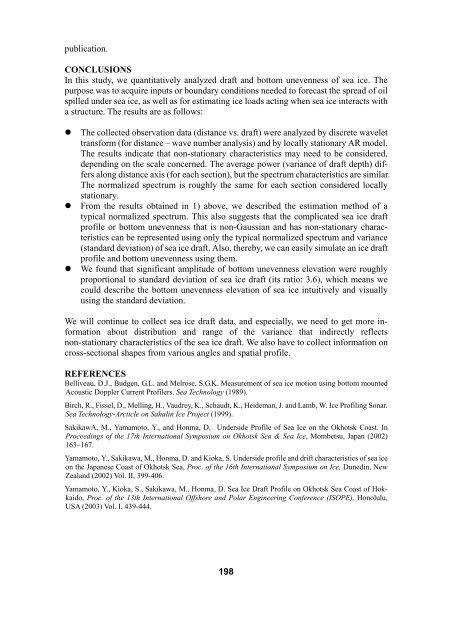You also want an ePaper? Increase the reach of your titles
YUMPU automatically turns print PDFs into web optimized ePapers that Google loves.
publication.<br />
CONCLUSIONS<br />
In this study, we quantitatively analyzed draft and bottom unevenness of sea ice. The<br />
purpose was to acquire inputs or boundary conditions needed to forecast the spread of oil<br />
spilled under sea ice, as well as for estimating ice loads acting when sea ice interacts with<br />
a structure. The results are as follows:<br />
• The collected observation data (distance vs. draft) were analyzed by discrete wavelet<br />
transform (for distance – wave number analysis) and by locally stationary AR model.<br />
The results indicate that non-stationary characteristics may need to be considered,<br />
depending on the scale concerned. The average power (variance of draft depth) differs<br />
along distance axis (for each section), but the spectrum characteristics are similar.<br />
The normalized spectrum is roughly the same for each section considered locally<br />
stationary.<br />
• From the results obtained in 1) above, we described the estimation method of a<br />
typical normalized spectrum. This also suggests that the complicated sea ice draft<br />
profile or bottom unevenness that is non-Gaussian and has non-stationary characteristics<br />
can be represented using only the typical normalized spectrum and variance<br />
(standard deviation) of sea ice draft. Also, thereby, we can easily simulate an ice draft<br />
profile and bottom unevenness using them.<br />
• We found that significant amplitude of bottom unevenness elevation were roughly<br />
proportional to standard deviation of sea ice draft (its ratio: 3.6), which means we<br />
could describe the bottom unevenness elevation of sea ice intuitively and visually<br />
using the standard deviation.<br />
We will continue to collect sea ice draft data, and especially, we need to get more information<br />
about distribution and range of the variance that indirectly reflects<br />
non-stationary characteristics of the sea ice draft. We also have to collect information on<br />
cross-sectional shapes from various angles and spatial profile.<br />
REFERENCES<br />
Belliveau, D.J., Budgen, G.L. and Melrose, S.G.K. Measurement of sea ice motion using bottom mounted<br />
Acoustic Doppler Current Profilers. Sea Technology (1989).<br />
Birch, R., Fissel, D., Melling, H., Vaudrey, K., Schaudt, K., Heideman, J. and Lamb, W. Ice Profiling Sonar.<br />
Sea Technology-Arcticle on Sahalin Ice Project (1999).<br />
SakikawA, M., Yamamoto, Y., and Honma, D. Underside Profile of Sea Ice on the Okhotsk Coast. In<br />
Proceedings of the 17th International Symposium on Okhotsk Sea & Sea Ice, Mombetsu, Japan (2002)<br />
163–167.<br />
Yamamoto, Y., Sakikawa, M., Honma, D. and Kioka, S. Underside profile and drift characteristics of sea ice<br />
on the Japanese Coast of Okhotsk Sea, Proc. of the 16th International Symposium on Ice, Dunedin, New<br />
Zealand (2002) Vol. II, 399-406.<br />
Yamamoto, Y., Kioka, S., Sakikawa, M., Honma, D. Sea Ice Draft Profile on Okhotsk Sea Coast of Hokkaido,<br />
Proc. of the 13th International Offshore and Polar Engineering Conference (ISOPE), Honolulu,<br />
USA (2003) Vol. I, 439-444.<br />
198

















